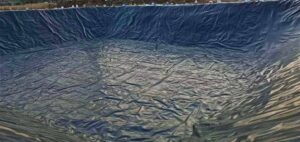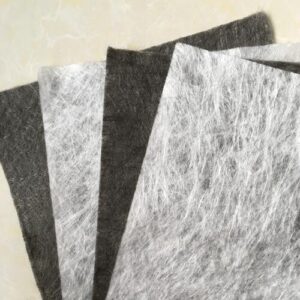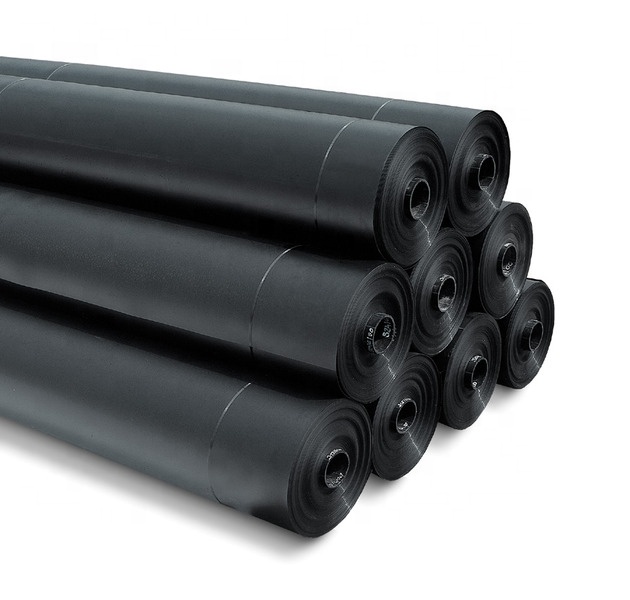What is a geomembrane mat?
Grooved geomembrane refers to grooved geocomposite membrane, also known as “geomembrane pad”. It is a multi-layered composite material that usually includes the following main components:
Bentonite: The core part of the grooved geomembrane is usually a layer of natural or artificial bentonite, such as montmorillonite or illite. These soils are highly water-swellable and can swell when exposed to water, forming an impermeable layer.
Non-woven or woven geotextile: Bentonite clay is often sandwiched between two layers of non-woven or woven geotextile to strengthen its structure and prevent leaks. These geotextiles are usually made from synthetic materials such as polypropylene or polyester.
Groove surface: Usually, the geotextile on one side will be coated with a groove-shaped anti-seepage adhesive layer. These grooves are the source of the name of the groove surface geomembrane. The groove surface helps to increase the bonding between the geomembrane and other surfaces, thereby improving the anti-seepage performance.
Grooved geomembranes are mainly used in anti-seepage applications, such as landfills, dams, pools, sewage treatment facilities, mining waste dumping areas and other projects. Its main function is to prevent liquid penetration, prevent environmental pollution, and protect groundwater resources.
The advantages of trench geomembranes include higher impermeability, sustainability, chemical resistance and durability. It is a common material in the field of geotechnical engineering, used to protect the environment and engineering structures from liquid leakage.

Application areas of geomembrane mats
Geomembrane mat is a multi-functional geotechnical material mainly used to prevent seepage, separate, protect and enhance various land engineering and environmental applications. They play an important role in a variety of applications, including the following major areas:
Landfills: GCLs are commonly used in anti-seepage systems in landfills. They are used as bottom impermeable cushions to prevent waste seepage and prevent contamination of groundwater.
Dams and embankments: In dam and embankment projects, geomembrane mats can be used to enhance the anti-seepage performance of earth dams, prevent water seepage, and protect the earth dam structures from erosion.
Pools and Lakes: Used to create ponds, lakes and reservoirs to keep bodies of water leak-proof. GCLs can help maintain water levels and quality in water bodies.
Wastewater treatment: In wastewater treatment facilities, GCLs can be used as bottom anti-seepage layers to prevent treatment wastewater from leaking into groundwater.
Mining: In mines and mining activities, GCLs can be used as anti-seepage cushions for the treatment of mine waste and tailings.
Land Fill: In land fill projects, GCLs can be used to prevent fill material from leaking into the surrounding environment, thus preventing land subsidence and water pollution.
Environmental protection: GCLs are also used in many other environmental engineering applications, such as sedimentation tanks, wetland restoration, anti-seepage of oil sewage tanks, etc.
Tunnels and Underground Projects: In underground projects, GCLs can be used to prevent groundwater from seeping into tunnels or other underground structures, thus keeping them dry.
Road and Railway Works: GCLs are also used in road and railway works to enhance the subgrade structure and provide drainage and separation functions.
In summary, geomembrane mats are widely used in various land engineering and environmental applications, mainly for anti-seepage, separation, protection and reinforcement to improve the performance and sustainability of projects. Their selection and application depends on the needs and conditions of the specific project.

Advantages of geomembrane mats
Geomembrane mats have many advantages that make them a widely used material in geotechnical and environmental engineering. Here are some of the main advantages:
Anti-seepage performance: The geomembrane mat has excellent anti-seepage performance and can effectively prevent liquids, gases or chemicals from penetrating into the soil or groundwater. This helps protect the environment and prevent groundwater contamination.
Separation function: They can be used to separate different materials, such as soil and filler, to prevent mixing and impurity infiltration and improve the stability of the project.
Durability: Geomembrane mats typically have a long life and are able to withstand the stress and pressure of varying environmental conditions, providing long-lasting performance.
Lightweight and easy to install: Compared with traditional clay anti-seepage layers, GCLs are lighter and easier to transport and install, thus reducing project costs and time.
Quality Control: They are often prefabricated in factories and can be manufactured in a quality-controlled environment, ensuring consistency and repeatability.
Environmentally friendly: Geomembrane mats are often made from recyclable materials, helping to reduce resource waste and environmental impact. They also help protect soil and water resources and reduce land pollution.
Chemical Resistance: GCLs are generally resistant to corrosion by many chemicals and are suitable for applications that require handling of corrosive liquids.
Economics: Although the initial investment may be higher, geomembrane mats are often competitive in terms of overall cost when considering long-term performance and maintainability.
Versatility: They can be used in a variety of applications including landfills, dams, sewage treatment, mining, road and rail projects, etc., making them a versatile geotechnical material.
Overall, the advantages of geomembrane mats include providing superior impermeability and separation properties, durability, environmental friendliness, and versatility for a variety of engineering projects. These properties make it widely used in geotechnical and environmental engineering.
Author

Founded in 2002, Tinhy's team focuses on the manufacturing, marketing, installation, application and research and development of geosynthetic materials.
View all posts





